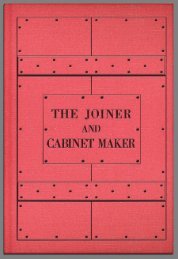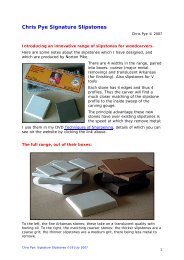CHASING THREADS IN WOOD - Tools for Working Wood
CHASING THREADS IN WOOD - Tools for Working Wood
CHASING THREADS IN WOOD - Tools for Working Wood
- No tags were found...
Create successful ePaper yourself
Turn your PDF publications into a flip-book with our unique Google optimized e-Paper software.
the rate of speed necessary. A few practicemotions like this allows you to getthe feel <strong>for</strong> the speed. The more teethto the inch the easier it is to handle thechaser, because you are progressingslower. Once you feel you have thespeed down, allow it to cut lightly andmove it evenly and smoothly (not faltering)at the desired speed. This is called“striking the thread”. Once you havegrooves cut deep enough to guide thechaser, you no longer have to move it,but you do have to lift it out of thegrooves be<strong>for</strong>e it reaches the bottom ofthe hole. You must exert care to insertthe tool into the grooves each time, missand you may cut a double or triplethread, not good!Fig. 5. The armrest is a smooth steel shaftabout seven to nine inches in length andabout 1/4 inch thick. The face is about 1/2inch wide at the handle and less than 1/4inch at the end where it is turned up at 90degrees. The handle will be from 13 to 15inches long with a hole drilled <strong>for</strong> a string.The string is long enough to allow thearmrest to hang down your left side, but stillbe manipulated to hold the metal end on thetool rest and the handle under the upperarm and pressed against the side. The lefthand grasps the tool rest and the left thumbpresses the tool down onto the armrest andthe entire assembly down onto the tool rest.The tool rests against the hook on thearmrest so that side pressure can be appliedas the threads are cut.Until recently, I turned the “T”across the face of the area to bethreaded, wrapped my fingers aroundthe tool rest and hooked my index fingerover the chaser to apply pressureagainst the cylinder during cutting. I recentlyacquired an “arm rest” , Fig. 5,which considerably aids in cutting insidethreads. You place the handle under yourleft arm, the arm rest on the “T” and thechaser on the arm rest with the hook(turned up part) touching the chaser. Thearm rest is then tilted up and down asnecessary to position the chaser and ispulled back to exert pressure during thecut. It makes cutting the inside threadmuch easier. Both Bill Jones and AllanBatty consider the armrest indespensible<strong>for</strong> internal thread chasing. I say it is alot easier, I was making threads withoutit.Make additional passes until thethread is deep enough and clean. If youhave a specific size that you are tryingto achieve, you can measure the insidewith calipers and if necessary shave offa little bit with a side cutting tool, makesure the sides remain parallel to the axisof rotation and do not remove all of thethread, leave enough to guide the chaser<strong>for</strong> additional passes. Then make morepasses until you have a good threadagain. I do not hesitate to rotate the latheby hand and make a few passes withthe chaser at this very slow speed asfinal touch up. If you were to slice thefinished piece in half, you should have athread that appears to be very similar tothat shown in Fig. 6.Fig. 6. If you were to slice your newly cutthreaded section into half, the threadsshould look something like this. Note thatthe recess allows the thread to be cut cleanat the bottom of the hole.Now, prepare the outside threadarea similar to that shown in Fig. 7. TheFig. 7. The section prepared <strong>for</strong> cutting anexternal thread should appear similar to thisdrawing. Again the recess is to allow thethread to be cut cleanly at the rear of thesection. There is a tapered section at thebeginning to prevent the chaser fromcatching on a sharp edge. There is also alittle tenon (shaded section) that is the sizeof the bottom of the thread. This section isremoved after the thread has been cut. Theminimum diameter of the threaded area isequal to twice the depth of the thread plusthe diameter of this little tenon.Fig. 8. This drawing illustrates how thetenon on the end of the section to bethreaded is sized. The inside thread shouldjust fit over the tenon. Thus, you have createda marker <strong>for</strong> the bottom of the outside thread.When the chaser marks the tenon, the insidethread should screw onto the outside thread.sides of the cylinder must be parallel tothe axis of rotation, there must be a recesscut at the end of the threaded area,there must be a bevel or rounded areaat the beginning of the threaded area,and there must be a little tenon (shadedarea in the figure) that will just fit insidethe female threaded area, see Fig. 8. Theoutside of the cylinder must be at leasttwice the depth of the threads larger thanthis area; i.e., if the thread depth is0.025" then the diameter must be greater
than 0.050" larger than the tenon as avery minimum. I recommend that it be abit larger to allow <strong>for</strong> mistakes in gettingstarted. This is especially importantwhen learning this technique.Fig. 9. This drawing illustrates the movementof the chaser as it cuts the thread. The chasershould just cut into the recess and then belifted clear of the wood be<strong>for</strong>e the chasercomes in contact with the shoulder. Whenthe chaser just marks the shaded tenon, thethread should be ready to receive the insidethreaded piece.Be<strong>for</strong>e actually starting to movethe chaser along the tool rest, it is importantthat the rest be dressed smooth,any nick or rough spot can stop or causethe chaser to falter and create problemswith your thread. Again, with the areabelow the cutting edge rubbing on thewood get a feel <strong>for</strong> the rate of feed thatwill be necessary. Make a few trialpasses be<strong>for</strong>e allowing the tool to startcutting. Then move the tool along evenlyat the determined speed allowing theedge to cut lightly as shown in Fig. 9.As the cutter moves into the recess atthe end of the thread area pull it awayfrom the wood and reapply at the beginning.Your chaser should be movingfrom right to left. Repeat this operationuntil the thread is well <strong>for</strong>med. If thechaser hasn’t started to make scratcheson the small tenon (shaded area on theillustration), use a square end scraperand take a light cut on top of the threads.Then cut the threads deeper until thechaser just cuts on the small tenon. IfThis set of Ray Iles thread chasers are the best that I’ve used. Bottom is outside chaser,middle is inside chaser, and top is recess cutter <strong>for</strong> inside threads.Figure 10. Your finished outside threadshould look something like this. You wantgood sharp “V” bottoms to your threads,but you do not want a sharp “V” on the topof the thread. Each thread should have alittle flat. A sharp edge is easy to chip.everything was done properly, i.e., thethreaded area was parallel to the axis ofrotation and the threads are cut to thecorrect depth, the female thread shouldscrew onto the threads you’ve just cut.You may still have to relieve this a bit. Igenerally turn off the lathe and rotate itby hand while making some final passeswith the chaser. Then try your nut or lidagain. If it screws on fully, but is a littlestiff, apply some soft wax and work it abit. If that still doesn’t free it up, thentake another pass with the chaser whilerotating by hand. When everything fits,your thread should look something likethe thread shown in Fig. 10.Clean the threads with a soft clothand apply a light coat of soft wax as afinish. Work the threads a bit to burnishthem.Well that is about all there is to it.As Bill Jones says, “start making littleboxes with threaded lids, by the timeyou’ve made half a gross, you’ll be athread chaser.” Once you have the toolsand the inclination and a little bit of knowhow, all that remains is a lot of practice.Remember, a lathe with a speed of 100to 200 rpm would be best. Lacking that,try chasing threads while hand turningthe lathe. Start with a fine thread (16tpi to 24 tpi) in the beginning and use agood hard wood. One of the best thatI’ve used isAfrican Blackwood, it is abit pricey but it sure makes a nice thread.Source <strong>for</strong> Ray Iles Chasers:<strong>Tools</strong> For <strong>Working</strong> <strong>Wood</strong>27West 20th Street, Suite 507New York, NY 10011TEL: 800-426-4613www.tools<strong>for</strong>workingwood.com













